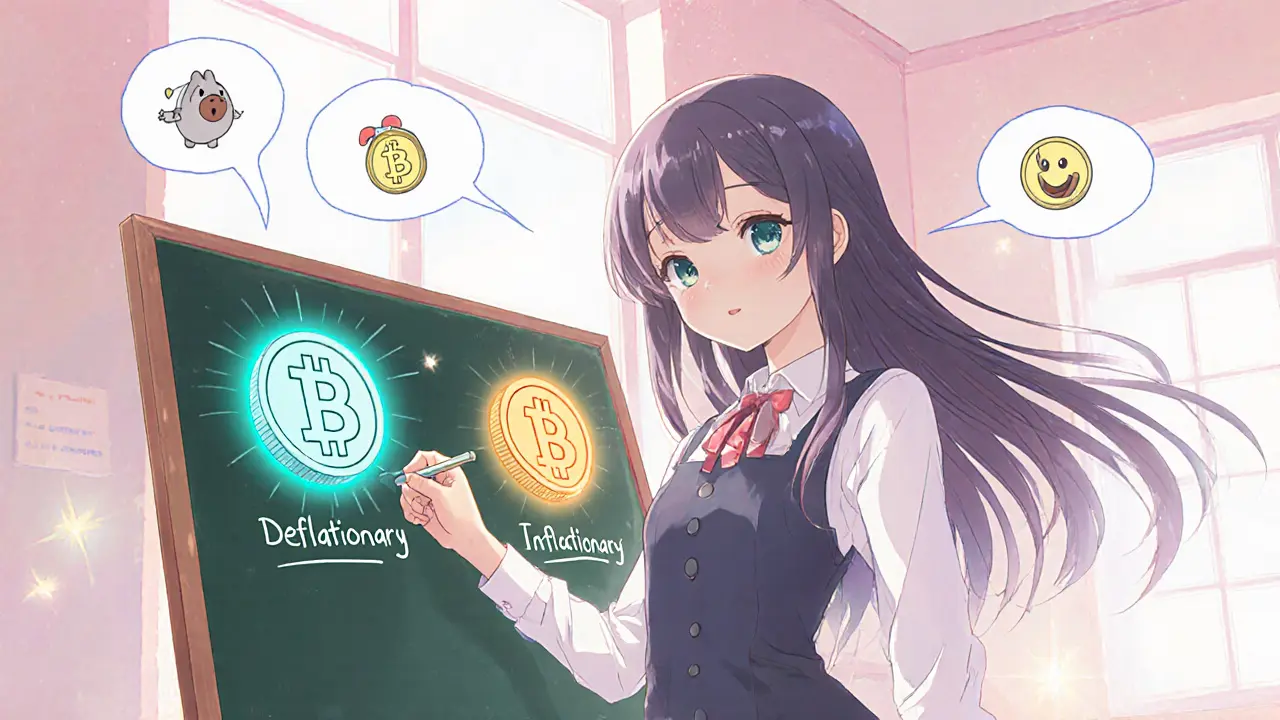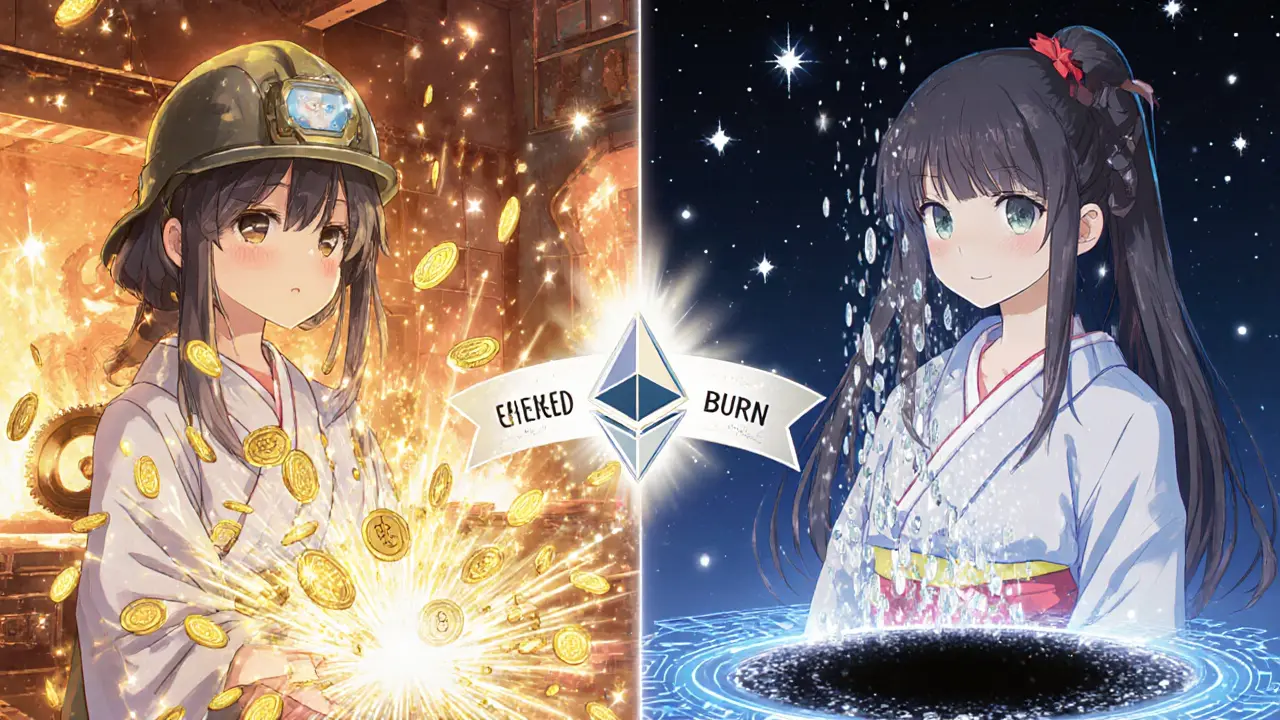Deflationary vs Inflationary Tokens: Key Differences & Investment Impact
 Oct, 3 2025
Oct, 3 2025
Token Supply Model Explorer
Supply Model Analysis
Model Type:
Simulation Period: years
Expected Outcome:
Supply Trend Visualization
Key Economic Implications
Token Supply Model Comparison
Deflationary
Capped supply or burning mechanisms
Inflationary
Continuous issuance
Hybrid
Combines both approaches
When you hear people argue about Bitcoin’s scarcity or Dogecoin’s endless supply, they’re really debating two opposite money ideas: Deflationary Token a digital asset whose circulating supply shrinks or stays capped, creating built‑in scarcity versus Inflationary Token a digital asset that continuously adds new units, expanding the overall supply over time. Understanding how each model works, why developers choose one over the other, and what it means for your wallet can save you from costly mistakes.
Supply Mechanics: How Tokens Grow or Shrink
At the heart of every token is a protocol‑defined rule that tells the system when new coins appear or disappear.
- Mining Rewards new coins issued to proof‑of‑work miners for validating blocks - classic inflation, used by Bitcoin in its early years.
- Staking Rewards tokens granted to proof‑of‑stake validators for securing the network - adds a steady stream of supply in networks like Ethereum.
- Token Burning permanent removal of tokens from circulation, often a percentage of transaction fees - creates deflation.
In an inflationary token model, the protocol may have a hard cap (e.g., 1billion tokens) but still mint new units until that limit is reached, or it may be uncapped entirely, as with Dogecoin’s unlimited supply. In a deflationary token model, the supply either never exceeds a preset ceiling (Bitcoin’s 21million) or it actively drops via burning mechanisms that offset any new issuance.
Economic Philosophy: Spend or Save?
Supply rules shape user behavior. When tokens keep multiplying, each holder’s slice gets thinner, nudging people to spend or stake quickly. That’s why many inflationary tokens are built for high‑velocity use cases like payments and DeFi incentives.
Conversely, a shrinking or capped supply fuels a “digital gold” mindset. Holders expect scarcity to push prices up, so they lock their coins away, aiming for capital appreciation rather than everyday transactions. Projects that champion this view-Bitcoin, many layer‑1s with fixed caps-market themselves as stores of value and hedges against fiat inflation.
Price Dynamics and Volatility
Because inflation fuels a constantly expanding pool of coins, price swings tend to be less dramatic when demand keeps pace. The extra supply absorbs buying pressure, keeping markets smoother. However, if demand stalls, the same inflation can wash out value, as seen when Dogecoin’s price plunged after community hype faded.
Deflationary assets, on the other hand, experience sharper price moves. Any surge in buying pressure hits a limited pool, driving prices up quickly. That’s why Bitcoin’s rallies often look like rockets, but the same scarcity can also cause steep drops when sentiment turns sour-there’s simply less liquidity to cushion the fall.
Real‑World Examples
Below is a quick snapshot of four well‑known tokens and where they sit on the supply spectrum.
| Token | Supply Type | Cap / Mechanism | Primary Use Case |
|---|---|---|---|
| Bitcoin first cryptocurrency with a 21million hard cap | Deflationary | Fixed 21M, halving every 4years | Store of value, institutional reserve |
| Ethereum hybrid model: staking rewards vs EIP‑1559 fee burning | Hybrid | Staking adds ~4% yearly; fee burning can offset | Smart contracts, DeFi, dApps |
| Dogecoin unlimited supply, ~5B new DOGE per year | Inflationary | No cap, continuous issuance | Community tipping, low‑value transactions |
| Polygon (MATIC) inflationary with periodic token burns from fees | Hybrid | Annual inflation ~2% minus burn | Layer‑2 scaling, DeFi liquidity |

Advantages and Drawbacks
Inflationary tokens bring a few clear perks:
- Steady liquidity - new coins keep markets liquid.
- Funding on‑chain projects - issuance can finance development without external fundraising.
- Lower price volatility in healthy demand cycles.
But they also risk diluting value if the supply outpaces demand. Unlimited models like Dogecoin can become “digital confetti” unless strong network effects keep users buying.
Deflationary tokens shine when investors seek scarcity:
- Potential for high appreciation - each new holder owns a larger slice of a shrinking pie.
- Hedge against fiat inflation - many institutions treat Bitcoin as a digital reserve.
- Strong community identity - scarcity fuels narrative and brand loyalty.
The flip side is reduced transactional appeal. If everybody wants to hold, there’s less daily spend, which can hinder mainstream adoption for payments.
Design Trends: Blending the Two Models
Newer projects recognize that pure inflation or pure deflation may not serve all goals. Hybrid tokenomics allow governance to adjust issuance rates, trigger burns when network usage spikes, or introduce “burn‑or‑mint” windows that react to market conditions. Ethereum’s switch to proof‑of‑stake plus EIP‑1559 is a milestone, showing that a protocol can be both inflationary (staking) and deflationary (fee burn) at the same time.
Other experimental designs include annual supply reductions (e.g., a 2.5% token burn each year) or dynamic inflation that slows as user adoption climbs. These approaches aim to smooth price volatility while preserving enough incentive for validators and developers.
Choosing the Right Token for Your Strategy
If you’re a trader looking for high‑risk, high‑reward swings, deflationary tokens often provide the sharp moves you thrive on. For long‑term portfolio stability, consider a mix: a core holding of a store‑of‑value deflationary asset like Bitcoin, complemented by an inflationary token that fuels yield farming or staking income.
Institutional investors tend to allocate a larger share to deflationary assets for balance‑sheet protection, while DeFi protocols allocate inflationary tokens to reward liquidity providers and bootstrap network effects.
Key Takeaways
- Supply mechanics (mining, staking, burning) dictate whether a token is inflationary or deflationary.
- Inflation encourages spending and rapid ecosystem growth; deflation encourages hoarding and price appreciation.
- Hybrid models are becoming mainstream, offering flexibility and smoother economics.
- Match the token’s supply model to your investment horizon and use‑case needs.
Frequently Asked Questions
What defines a deflationary token?
A deflationary token either has a hard cap on total supply (like Bitcoin) or incorporates mechanisms-most commonly token burning-that permanently remove coins from circulation, creating scarcity over time.
How does inflation affect token price?
Continuous issuance can dilute each holder’s share, putting downward pressure on price if demand does not rise at the same pace. However, predictable inflation can also fund development and keep markets liquid.
Can a token be both inflationary and deflationary?
Yes. Ethereum is a prime example: staking rewards create new ETH (inflation) while EIP‑1559 fee burning destroys ETH during high traffic periods, leading to net‑deflationary phases.
Which token type is better for everyday payments?
Inflationary tokens generally suit payments because their expanding supply reduces hoarding incentives, making users more willing to spend.
How do token burns work?
A burn transaction sends tokens to an irrecoverable address (often called a “black hole”). The protocol records the reduction, lowering the total circulating supply permanently.

Marie-Pier Horth
October 3, 2025 AT 18:09When you look at the token world, you realize we are living a drama of scarcity versus abundance. Each model tells a tale of human desire-whether we cling to the impossible dream of endless supply or chase the illusion of limited treasure. The deflationary narrative feels like a tragic hero, noble but doomed to be hoarded. Inflationary tokens, on the other hand, act like the bustling market of a carnival, ever‑growing and noisy. Both are reflections of our own impulses, and the choice we make says more about us than the coins themselves. In the end, the market simply mirrors the stories we write.
Gregg Woodhouse
October 10, 2025 AT 00:09meh, same old hype.
F Yong
October 16, 2025 AT 06:09Ah, the classic inflation‑deflation debate-another grand conspiracy to keep us guessing. Supposedly, the burning mechanisms are for the good of the ecosystem, but who's really benefitting? Probably the same shadowy developers who love a good token burn to pump prices while we, the naïve holders, keep buying more. It's all a carefully crafted illusion of scarcity versus abundance, designed to keep us tethered to a perpetually shifting narrative. And of course, every new token claims it's the 'future of money' while secretly reinforcing the same old power structures.
Sara Jane Breault
October 22, 2025 AT 12:09Both token types have their place. Deflationary coins can act as a store of value and help preserve wealth over time. Inflationary ones keep liquidity flowing and encourage daily use. Think about your own goals when choosing which suits you best.
Adeoye Emmanuel
October 28, 2025 AT 18:09Let us embark on a grand intellectual pilgrimage through the ether of tokenomics, where each token type stands as a philosophical beacon guiding the future of finance. The deflationary token, with its immutable cap, evokes the ancient notion of scarcity, a concept that humanity has revered since the days of scarce resources and precious metals. Its very existence whispers promises of preservation, of a digital gold that resists the erosive forces of time, inviting us to hoard, to cherish, to protect. Yet, this very reverence can turn into fatal inertia, a stagnation of activity, where the desire to spend is eclipsed by the fear of losing future appreciation. On the other side, the inflationary token embodies the relentless churn of modern economies, a testimony to perpetual growth, an ode to the ceaseless creation of value. By constantly minting new units, it fuels liquidity, ensuring that markets remain vibrant, that ecosystems thrive, and that participants are rewarded for their contributions. However, this bounty comes at a price: the dilution of each holder’s share, a slow erosion that can devalue holdings if demand does not keep pace. The hybrid model, a harmonious marriage of both principles, seeks balance-a dance between expansion and contraction, where token issuance can be adjusted in response to network activity, and burns can be triggered to counteract inflationary pressure. Ethereum’s transition to proof‑of‑stake, coupled with EIP‑1559 fee burning, exemplifies such a symbiotic relationship, where staking rewards introduce new ether while transaction fees erase it, potentially creating net‑deflationary periods. In practical terms, investors must align these token mechanics with their strategic horizons: short‑term traders may gravitate toward deflationary assets for their sharp price rallies, while long‑term custodians might prefer the steady, predictable returns of inflationary tokens to fund staking or yield farming. Institutions, seeking stability, often allocate a core of deflationary assets as a hedge against fiat devaluation, paired with inflationary tokens to maintain liquidity in their portfolios. Moreover, developers must consider the incentives for validators and users; too much scarcity may discourage participation, whereas unchecked inflation can render the token worthless. Ultimately, the token’s supply model is not merely a technical parameter but a narrative that shapes user behavior, market dynamics, and the very ethos of the blockchain community. By understanding the philosophical underpinnings and economic consequences, we empower ourselves to make informed choices amidst the ever‑evolving landscape of digital assets.
Rahul Dixit
November 4, 2025 AT 00:09obviously, it’s all just a ploy.
CJ Williams
November 10, 2025 AT 06:09Hey folks! 🚀 Let’s remember that tokenomics isn’t just about numbers-it's about community spirit! 🌟 When we burn tokens, we’re actually lighting a fire 🔥 that can motivate developers to innovate. And when new tokens are minted, they can fund awesome projects that bring real value. So, keep the conversation constructive, share knowledge, and let's grow together! 💪💡
mukund gakhreja
November 16, 2025 AT 12:09sure sure, burn it all, but what about the users? they’ll just sit on their coins. no real use case if everyone is just waiting for the price to skyrocket.